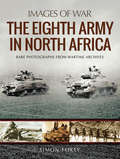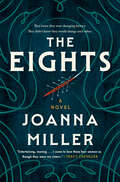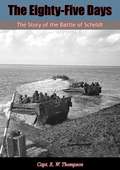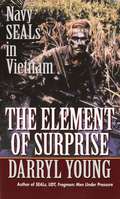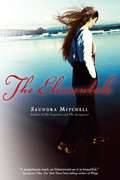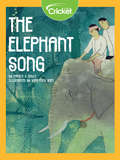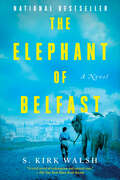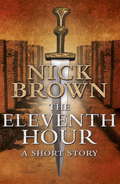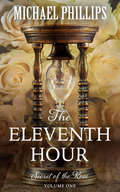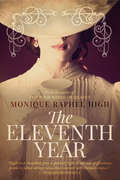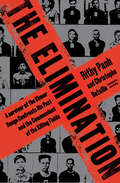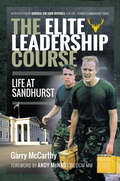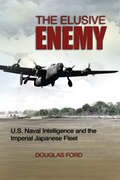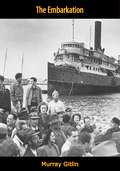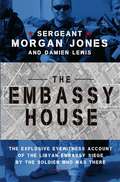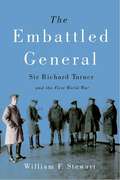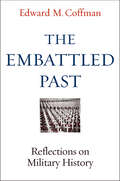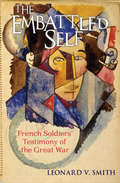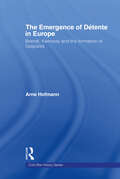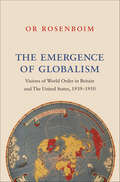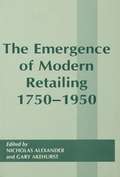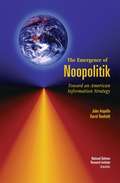- Table View
- List View
The Eighth Army in North Africa: Rare Photographs From Wartime Archives (Images of War)
by Simon FortyA pictorial history of the British Eighth Army&’s campaigns in Egypt, Libya, and Tunisia during World War II. The British Eighth Army, which played a decisive role in defeating the Axis in North Africa, was one of the most celebrated Allied armies of the Second World War, and this photographic history is the ideal introduction to it. The carefully chosen photographs show the men, weapons, and equipment of the army during campaigns in Egypt, Libya, and Tunisia. The battles the army fought in the Western Desert in 1941 and 1942 are the stuff of legend, as is the second Battle of El Alamein when, under Montgomery, it defeated the German and Italian forces commanded by Rommel. With vivid insight into the fighting and the desert conditions, this book shows what a varied, multinational force the army was, for it brought together men from Britain and the British Empire and Commonwealth as well as Free French, Greeks, and Poles.
The Eights
by Joanna MillerThey knew they were changing history. They didn&’t know they would change each other. Following the unlikely friendship of four women in the first female class at Oxford, their unshakeable bond in the face of male contempt, and their coming of age in a world forever changed by World War I.&“Entertaining and moving…I came to love these four women as though they were my sisters.&”—TRACY CHEVALIER, #1 New York Times bestselling authorOxford, 1920. For the first time in its one-thousand-year history, Oxford University officially admits female students. Burning with dreams of equality, four young women move into neighboring rooms in Corridor 8. Beatrice, Dora, Marianne, and Otto—collectively known as The Eights—come from all walks of life, each driven by their own motives, each holding tight to their secrets, and are thrown into an unlikely, unshakable friendship.Dora was never meant to go to university, but, after losing both her brother and her fiancé on the battlefield, has arrived in their place. Politically-minded Beatrice, daughter of a famous suffragette, sees Oxford as a chance to make her own way - and some friends her own age. Otto was a nurse during the war but is excited to return to her socialite lifestyle in Oxford where she hopes to find distraction from the memories that haunt her. And finally Marianne, the quiet, clever daughter of a village pastor, who has a shocking secret she must hide from everyone, even her new friends, if she is to succeed.Among the historic spires, and in the long shadow of the Great War, the four women must navigate and support one another in a turbulent world in which misogyny is rife, influenza is still a threat, and the ghosts of the Great War don&’t always remain dead.
The Eighty-Five Days: The Story of the Battle of Scheldt
by Capt. R. W. ThompsonAn explosive story of blunders and courage in the battle that might have brought victory in Europe in 1944.“I believe my book could be described as an attempt at an heroic history of a very long and important battle, which is truly a series of battles. All the events ‘depicted’ in it happened, and if I have erred it has been on the side of understatement, for heroism often is beyond the ordinary use of prose, and if one feels unable to express it beyond a doubt it is better to let it speak for itself in the deed….”—Foreword
The Element of Surprise: Navy SEALS in Vietnam
by Darryl YoungIt used to be said that the night belonged to Charlie. But that wasn't true where SEALs patrolled. For six months in 1970, fourteen men in Juliett Platoon of the Navy's SEAL Team One--incuding the author--carried out over a hundred missions in the Mekong Delta without a single platoon fatality. Their primary mission: kidnap enemy soldiers--alive--for interrogation.From the Paperback edition.
The Elementals
by Saundra MitchellKate Witherspoon has lived a bohemian life with her artist parents. In 1917, the new art form of the motion picture is changing entertainment--and Kate is determined to become a director. Meanwhile, midwestern farm boy Julian Birch has inherited the wanderlust that fueled his parents' adventures. A childhood bout with polio has left him crippled, but he refuses to let his disability define him. Strangers driven by a shared vision, Kate and Julian set out separately for Los Angeles, the city of dreams. There, they each struggle to find their independence. When they finally meet, the teenage runaways realize their true magical legacy: the ability to triumph over death, and over time. But as their powerful parents before them learned, all magic comes with a price.on to The Vespertine and The Springsweet, the teenage children of the heroes of the previous novels confront a decades-old tragedy still unfolding. At the crucial moment, will Kate and Julian have the courage to embrace their gifts?
The Elephant Song
by Pamela D. GauciAung lives in a small village in Burma (Malaysia) and spends his free time tending to the village elephants. Beyond his village, the world is at war, and invading Japanese troops are on their way.
The Elephant of Belfast: A Novel
by S. Kirk WalshInspired by true events, this vivid and moving story of a young woman zookeeper and the elephant she's compelled to protect through the German blitz of Belfast during WWll speaks to not only the tragedy of the times, but also to the ongoing sectarian tensions that still exist in Northern Ireland today—perfect for readers of historical and literary fiction alike.Belfast, October 1940. Twenty-year-old zookeeper Hettie Quin arrives at the city docks in time to meet her new charge: an orphaned three-year-old Indian elephant named Violet. As Violet adjusts to her new solitary life in captivity and Hettie mourns the recent loss of her sister and the abandonment of her father, new storm clouds gather. A world war rages, threatening a city already reeling from escalating tensions between British Loyalists and those fighting for a free and unified Ireland. The relative peace is shattered by air-raid sirens on the evening of Easter Tuesday 1941. Over the course of the next five hours, hundreds of bombs rain down upon Belfast, claiming almost a thousand lives and decimating the city. Dodging the debris and carnage of the Luftwaffe attack, Hettie runs to the zoo to make sure that Violet is unharmed. The harrowing ordeal and ensuing aftermath set the pair on a surprising path that highlights the indelible, singular bond that often brings mankind and animals together during horrifying times. Inspired by a largely forgotten chapter of World War II, S. Kirk Walsh deftly renders the changing relationship between Hettie and Violet, and their growing dependence on each other for survival and solace. The Elephant of Belfast is a complicated and beguiling portrait of hope and resilience--and how love can sustain us during the darkest moments of our lives.
The Eleventh Hour
by Nick BrownSyria, 262 AD. Imperial agent Abascantius has failed his superiors and now faces the unwelcome prospect of a return to the legions. With only hours to work with, he will need resourcefulness and ruthlessness in equal measure if he is to salvage the situation and save himself. From Agent of Rome author Nick Brown, this compelling short story is set in the violent, corrupt underbelly of third century Antioch.
The Eleventh Hour
by Nick BrownSyria, 262 AD. Imperial agent Abascantius has failed his superiors and now faces the unwelcome prospect of a return to the legions. With only hours to work with, he will need resourcefulness and ruthlessness in equal measure if he is to salvage the situation and save himself. From Agent of Rome author Nick Brown, this compelling short story is set in the violent, corrupt underbelly of third century Antioch.
The Eleventh Hour (Secret of the Rose #1)
by Michael PhillipsFamily and faith guide one man through the buildup to World War II in this unforgettable saga—first in the Secret of the Rose series. In 1930s pre-war Prussia, Baron von Dortmann lives an idyllic life with his daughter Sabina. A devoted gardener and father, the Baron teaches his daughter powerful lessons about life, creation, and God&’s love during treasured walks in the estate&’s beautiful gardens. But Sabina is growing up, and the Baron&’s beloved Prussia is changing. Now a beautiful young woman, Sabina has caught the eye of a handsome young American, Matthew. Meanwhile, a cloud is gathering on the horizon as the Nazis seize power in neighboring Germany. As he strives to protect his family and follow his own moral compass, Baron von Dortmann will face heart-wrenching decisions, with only God&’s guidance to light the way.&“Watching Sabina and her parents in the Secret of the Rose series as they dealt with Nazi antagonism caused me to ponder exactly what it would have been like to live amongst such challenges. Sabina&’s zest for life and faith in God are encouragement to live in a way that honors the Lord, no matter what life-threatening challenges may arise.&” —Kindred Grace
The Eleventh Year
by Monique Raphel HighTwo best friends. An artist and a writer. One rich. One poor. A lifetime of deception and betrayal. Upon graduating from Vassar, socialite Lesley Aymes Richardson and brilliant Jamie Lynne Stewart set out to achieve their dreams and begin their lives in hedonistic post World War I Paris in pursuit of art and pleasure . Both women have incurable urges to live and love, whatever the cost. But after a series of poor decisions and broken hearts, they discover a life far from the perfection they originally envisioned. Although Lesley finds a life of considerable renown, she harbors secrets that she keeps buried to maintain a certain level of decorum and respect. When a mysterious Russian princess threatens to expose a secret from her past, together she and Jamie must confront the truth, despite the consequences that may be unleashed. On the eve of her eleventh year of marriage, Lesley is forced to look back, to make a decision that will alter all of their lives forever.
The Elimination: A Survivor of the Khmer Rouge Confronts His Past and the Commandant of the Killing Fields
by John Cullen Christophe Bataille Rithy PanhFrom the internationally acclaimed director of S-21: The Khmer Rouge Killing Machine, a survivor's autobiography that confronts the evils of the Khmer Rouge dictatorship.Rithy Panh was only thirteen years old when the Khmer Rouge expelled his family from Phnom Penh in 1975. In the months and years that followed, his entire family was executed, starved, or worked to death. Thirty years later, after having become a respected filmmaker, Rithy Panh decides to question one of the men principally responsible for the genocide, Comrade Duch, who's neither an ordinary person nor a demon--he's an educated organizer, a slaughterer who talks, forgets, lies, explains, and works on his legacy. This confrontation unfolds into an exceptional narrative of human history and an examination of the nature of evil. The Elimination stands among the essential works that document the immense tragedies of the twentieth century, with Primo Levi's If This Is a Man and Elie Wiesel's Night.
The Elimination: A Survivor of the Khmer Rouge Confronts His Past and the Commandant of the Killing Fields
by Christophe Bataille Rithy PahnAbout this Book...From the internationally acclaimed director of S-21: The Khmer Rouge Killing Machine, a survivor&’s autobiography that confronts the evils of the Khmer Rouge dictatorship.Rithy Panh was only thirteen years old when the Khmer Rouge expelled his family from Phnom Penh in 1975. In the months and years that followed, his entire family was executed, starved, or worked to death. Thirty years later, after having become a respected filmmaker, Rithy Panh decides to question one of the men principally responsible for the genocide, Comrade Duch, who&’s neither an ordinary person nor a demon—he&’s an educated organizer, a slaughterer who talks, forgets, lies, explains, and works on his legacy. This confrontation unfolds into an exceptional narrative of human history and an examination of the nature of evil.The Elimination stands among the essential works that document the immense tragedies of the twentieth century, with Primo Levi&’s If This Is a Man and Elie Wiesel&’s Night.
The Elite Leadership Course: Life at Sandhurst
by Garry McCarthyThe only authentic account of Lord Rowallan’s ruthlessly unorthodox methods of leadership development at the Royal Military Academy Sandhurst."This is a brilliant account of how leadership is made." - Andy McNab This is the true story of 21 young men desperately trying to survive the most brutal leadership course of modern times. A throw back to the Highland Fieldcraft Training Center, the revolutionary brain child of Lord Rowallan during the Second World War, this fascinating insight explains the extraordinary lengths Sandhurst goes to in pursuit of generating the world’s greatest military leaders. No one could have known that the intensity of their training was coincidentally little more than a prelude to a decade of war in Afghanistan and Iraq where attrition rates became comparable to those reached during the Second World War. This captivating story is full of emotion brought on by physical and mental endeavor that leads to success and failure. This intimate and revealing story of camaraderie is the first of its kind. But learning how to lead subordinates during the darkest of hours, living in the most austere of environments comes at a price. Unconventional and at times controversial, this is the only authentic account of life in Rowallan Company Sandhurst at a time when the world teetered on the brink of war with insurgents and dictators armed with weapons of mass destruction.
The Elusive Enemy
by Douglas FordIn this exploration of U.S. naval operations and intelligence-gathering efforts, Douglas Ford introduces a new perspective on the clash between the United States and Japan in the Pacific. At the outset of the war, the U.S. Navy could not accurately determine the fighting efficiency of Japan's Imperial Navy and land-based fighting forces. As the capabilities designed to improve intelligence gathering evolved, technology, ingenuity, and sheer luck often combined to produce useful, but incomplete, information. Only through combat over an extended period of time, Ford demonstrates, did the U.S. Navy actually identify the capabilities of its adversary. The intense combat produced a trove of information obtained from prisoners, captured weapons, and documents, and firsthand accounts of American naval personnel often provided some the most actionable intelligence of the war.In recent years, a large number of documents related to intelligence activities during World War II has been declassified and made available in U.S. and British archives. As a result, a steady flow of work on the subject has emerged. However, much of the work on intelligence has focused on signals decrypts and clandestine operations. The subject of qualitative intelligence about the performance and fighting capabilities of the Imperial Japanese Navy has remained largely unexplored. The Elusive Enemy fills that void. As a historical case study, it demonstrates how intelligence plays a critical role in influencing the conduct of warfare and the manner in which threat perceptions influence international relations. It also serves as an explanation of cultural factors and their subsequent influence on U.S. and Japanese military practices. Finally, it is an innovative explanation of American perceptions regarding the Japanese during a critical period of history. Such a comprehensive examination of the impact of intelligence on the conduct of various campaigns is without parallel.
The Embarkation
by Murray GitlinWhat makes a Jew a Jew? This question is often heard among young American Jews who have not been brought up to understand the spiritual values which the Jews gave to the world. “The Embarkation,” Murray Gitlin’s emotional novel, first published in 1950, gives to a certain extent a psychological answer to this question.The central figure in the novel, Martin Tester, is an American soldier who is forced to become a deserter due to the anti-Semitism of his commander. He wanders around for two years in Italy, knowing that a court martial awaits him if he ever returns to the United States. An American who works for British Intelligence in Italy discovers him and guarantees that everything will be forgiven and forgotten, provided he spies on ships carrying “illegal” Jewish immigrants from Italy to Palestine. Having no choice, he accepts the offer. However, coming face to face with the first transport of Jewish refugees, he decides to help rather than denounce them to the British agents. He is helped in this by an Italian girl who falls in love with him and by other Italians of good will, who ask no questions…“The book is very well-written and makes absorbing reading.”—The Wisconsin Jewish Chronicle
The Embassy House: The Explosive Eyewitness Account of the Libyan Embassy Siege by the Soldier Who Was There
by Morgan JonesAn explosive eyewitness account of the 2012 attack on the American Embassy in Benghazi--told by the army veteran who risked his life to help American citizens and who found and identified the body of Ambassador Christopher Stevens. After the tragic siege on the US Embassy mission in Benghazi on September 11, 2012, Americans were left angry and confused, wondering: How could this have happened? So many questions were left unanswered by the Obama administration about that night in Benghazi...until now. Sergeant Morgan Jones, writing under a pseudonym for security purposes, is a twelve-year veteran of the British army who was the Project Manager for the security of the US Embassy in Benghazi. In The Embassy House, he delivers a riveting first-hand narrative of how the first American ambassador to die in a hostile act for over thirty years was killed and of the men who fought and died in an effort to save him. Reminiscent of the harrowing stories in military accounts like No Easy Day and American Sniper, The Embassy House is the gripping tale of a bloody, dark and desperate night. *Sergeant Jones's name and the names of others mentioned in The Embassy House have been changed for their security.
The Embattled General: Sir Richard Turner and the First World War
by William F. StewartLieutenant-General Sir Richard Turner (1871-1961) was a capable but controversial Canadian general who played a critical role in the development of the Canadian Corps up to 1917 and contributed significantly to its success thereafter. Despite his many accomplishments (including being awarded the Victoria Cross), Turner is often portrayed as a political appointee and repeated failure - representations that ignore, minimize, or misconstrue his successes as a combat commander and head of Canadian forces in England. In The Embattled General, William Stewart reveals Turner's tactical, operational, and administrative contributions to the Canadian war effort. Uniquely, Turner held senior commands in both combat arms and administration. Stewart narrates and analyzes Turner's successes and failures in the Boer War and the First World War's battles of Ypres, Festubert, St Eloi, and the Somme. He also studies Turner's career after his transfer to command Canadian forces in England in December 1916, where Turner reformed an administration in chaos. After the war, Turner post-war played a key role in the formation of the Royal Canadian Legion. Based on exhaustive research from over 1,200 volumes of material, including many previously untouched sources, The Embattled General provides a balanced and just re-evaluation of Turner, identifying his merits as well as his flaws.
The Embattled General: Sir Richard Turner and the First World War
by William F. StewartA re-evaluation of a controversial Canadian general that overturns much of what is known about him.
The Embattled Past: Reflections on Military History
by Edward M. CoffmanInternationally recognized for having reinvigorated and redefined his field, distinguished military historian Edward M. Coffman is a dedicated and much-admired teacher and mentor. In The Embattled Past, several of his most important essays have been assem
The Embattled Self: French Soldiers' Testimony of the Great War
by Leonard V. SmithHow did the soldiers in the trenches of the Great War understand and explain battlefield experience, and themselves through that experience? Situated at the intersection of military history and cultural history, The Embattled Self draws on the testimony of French combatants to explore how combatants came to terms with the war. In order to do so, they used a variety of narrative tools at hand--rites of passage, mastery, a character of the soldier as a consenting citizen of the Republic. None of the resulting versions of the story provided a completely consistent narrative, and all raised more questions about the "truth" of experience than they answered. Eventually, a story revolving around tragedy and the soldier as victim came to dominate--even to silence--other types of accounts. In thematic chapters, Leonard V. Smith explains why the novel structured by a specific notion of trauma prevailed by the 1930s. Smith canvasses the vast literature of nonfictional and fictional testimony from French soldiers to understand how and why the "embattled self" changed over time. In the process, he undermines the conventional understanding of the war as tragedy and its soldiers as victims, a view that has dominated both scholarly and popular opinion since the interwar period. The book is important reading not only for traditional historians of warfare but also for scholars in a variety of fields who think critically about trauma and the use of personal testimony in literary and historical studies.
The Emergence of Détente in Europe: Brandt, Kennedy and the Formation of Ostpolitik (Cold War History)
by Arne HofmannThis book examines the key relationship between Willy Brandt (the former Mayor of West Berlin and future West German Chancellor) and the administration of President John F. Kennedy. Arne Hofmann focuses on the administration’s influence on the development of Brandt’s ‘policy of small steps’ and the formation of his later Ostpolitik, the centrepiece of European détente. Brandt’s interaction with the Kennedy administration is traced through the Berlin Wall crisis of 1961, together with Kennedy’s search for a modus vivendi based on the status quo, the 1962 crisis in German-American relations, Brandt’s disillusionment campaign, the development of his programmatic statements, Brandt’s three meetings with the President including Kennedy’s famous visit to Berlin, the limited nuclear test ban treaty and Brandt’s Berlin pass agreement of Christmas 1963. While the narrative focuses on the gradual change in Brandt’s position, systematic parts concentrate on Brandt’s and Kennedy’s détente concepts, the triangular relationship between West Berlin, Washington and Bonn with its implication for domestic politics, and the role of images, campaigning and public opinion. The Emergence of Détente in Europe will appeal to students of Cold War history, foreign policy, international relations and international history in general.
The Emergence of Globalism: Visions of World Order in Britain and The United States, 1939–1950
by Or RosenboimHow competing visions of world order in the 1940s gave rise to the modern concept of globalismDuring and after the Second World War, public intellectuals in Britain and the United States grappled with concerns about the future of democracy, the prospects of liberty, and the decline of the imperial system. Without using the term "globalization," they identified a shift toward technological, economic, cultural, and political interconnectedness and developed a "globalist" ideology to reflect this new postwar reality. The Emergence of Globalism examines the competing visions of world order that shaped these debates and led to the development of globalism as a modern political concept.Shedding critical light on this neglected chapter in the history of political thought, Or Rosenboim describes how a transnational network of globalist thinkers emerged from the traumas of war and expatriation in the 1940s and how their ideas drew widely from political philosophy, geopolitics, economics, imperial thought, constitutional law, theology, and philosophy of science. She presents compelling portraits of Raymond Aron, Owen Lattimore, Lionel Robbins, Barbara Wootton, Friedrich Hayek, Lionel Curtis, Richard McKeon, Michael Polanyi, Lewis Mumford, Jacques Maritain, Reinhold Niebuhr, H. G. Wells, and others. Rosenboim shows how the globalist debate they embarked on sought to balance the tensions between a growing recognition of pluralism on the one hand and an appreciation of the unity of humankind on the other.An engaging look at the ideas that have shaped today's world, The Emergence of Globalism is a major work of intellectual history that is certain to fundamentally transform our understanding of the globalist ideal and its origins.
The Emergence of Modern Retailing 1750-1950
by Nicholas Alexander Gary AkehurstThe history of retail business development is an under-researched area. This book considers the emergence and development of modern retailing from an historical and management perspective in the period 1750-1950, addressing the need for further research and providing examples of current research activity. It considers the early emergence of retail forms in the late eighteenth century, the evolution of retail forms in the nineteenth century, and the late adaptation of retail management in the early twentieth century.
The Emergence of Noopolitik
by David Ronfeldt John Arquilla Dionne Barnes-Proby Elizabeth Williams John ChristianStrategy, at its best, knits together ends and means, no matter how various and disparate, into a cohesive pattern. In the case of a U.S. information strategy, this requires balancing the need to guard and secure access to many informational capabilities and resources, with the opportunity to achieve national aims by fostering as much openness as practicable. The authors' term to represent such strategic balancing is guarded openness. They go on to describe noopolitik (nu-oh-poh-li-teek)--an emerging form of statecraft that emphasizes the importance of sharing ideas and values globally, principally through the exercise of persuasive soft power rather than traditional military hard power. This study discusses the opportunities that may be raised by the emergence of noopolitik--ranging from construction of a noosphere (a globe-spanning realm of the mind) to recommendations that, for example, the U.S. military should begin to develop its own noosphere (among and between the services, as well as with U.S. allies). In the area of international cooperation, the authors offer strategic approaches for improving the capacity of state and nonstate actors to work together to address transnational problems. In addition, the authors recommend specific doctrinal developments, implied by the emergence of information strategy--including the pressing need to deal with such ethical concerns as the first use of information weapons, concepts of proportional response, and the need to maintain the immunity of noncombatants. Ultimately, the authors call for an innovative turn of mind as policymakers and strategists rethink how best to adapt to the epochal transformations being wrought by the information revolution.
